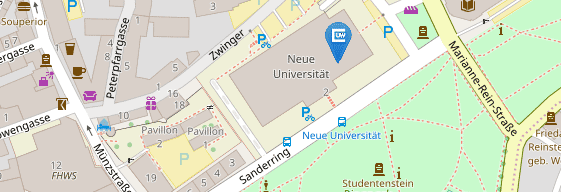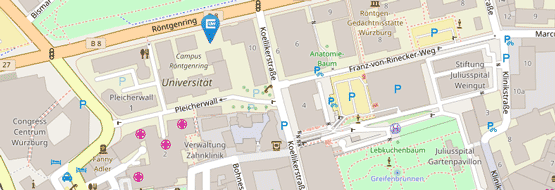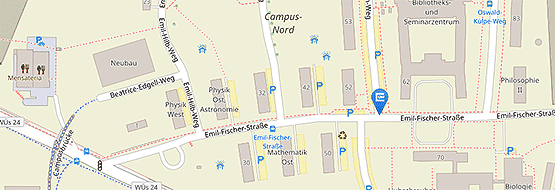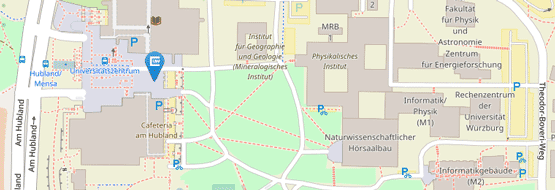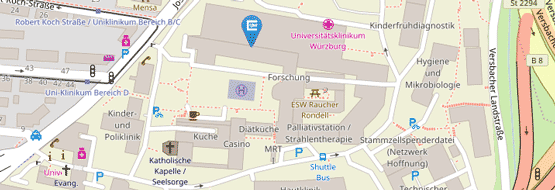Veröffentlichungen
Veröffentlichungen
2022[ to top ]
-
{The human cognition-enhancing CORD7 mutation increases active zone number and synaptic release}. . In Brain. 2022.
- [ URL ]
2021[ to top ]
-
Transcriptomic, peptidomic, and mass spectrometry imaging analysis of the brain in the ant Cataglyphis nodus. . In J Neurochem, 158(2), pp. 391–412. 2021.
-
The Pigment-Dispersing Factor neuronal network systematically grows in developing honey bees. . In Journal of Comparative Neurology, 530(9), pp. 1321–1340. 2021.
- [ URL ]
-
Natural Zeitgebers Under Temperate Conditions Cannot Compensate for the Loss of a Functional Circadian Clock in Timing of a Vital Behavior in Drosophila. . In J Biol Rhythms, 36(3), pp. 271–285. 2021.
-
Endocrine signals fine-tune daily activity patterns in Drosophila. . In Curr Biol, 31(18), pp. 4076–4087.e5. 2021.
-
Effects of temperature and photoperiod on the seasonal timing of Western honey bee colonies and an early spring flowering plant. . In Ecology and Evolution, 11(12), pp. 7834–7849. 2021.
- [ URL ]
-
The Neuropeptide PDF Is Crucial for Delaying the Phase of Drosophila’s Evening Neurons Under Long Zeitgeber Periods. . In J Biol Rhythms, 36(5), pp. 442–460. 2021.
2020[ to top ]
-
A Functional Clock Within the Main Morning and Evening Neurons of D. melanogaster Is Not Sufficient for Wild-Type Locomotor Activity Under Changing Day Length. . In Frontiers in Physiology, 11, p. 229. 2020.
- [ URL ]
-
Loss of function in the Drosophila clock gene period results in altered intermediary lipid metabolism and increased susceptibility to starvation. . In Cellular and Molecular Life Sciences, 77, pp. 4939–4956. 2020.
- [ URL ]
-
Post-embryonic Development of the Circadian Clock Seems to Correlate With Social Life Style in Bees. . In Frontiers in Cell and Developmental Biology, 8, p. 1325. 2020.
- [ URL ]
-
Single-cell resolution long-term luciferase imaging in cultivated Drosophila brains.. . 2020.
- [ URL ]
2019[ to top ]
-
How does timing of flowering affect competition for pollinators, flower visitation and seed set in an early spring grassland plant?. . In Sci Rep, 9(1), p. 15593. 2019.
-
Life at High Latitudes Does Not Require Circadian Behavioral Rhythmicity under Constant Darkness. . In Current Biology, 29(22), pp. 3928–3936.e3. 2019.
- [ URL ]
-
Distributed plasticity in ant visual pathways following colour learning. . In Proceedings of the Royal Society B: Biological Sciences, 286(1896), p. 20182813. 2019.
-
Honey bee waggle dance communication increases diversity of pollen diets in intensively managed agricultural landscapes. . In Molecular Ecology, 28(15), pp. 3602–3611. 2019.
- [ URL ]
-
A distinct visual pathway mediates high light intensity adaptation of the circadian clock in Drosophila. . In Journal of Neuroscience, 39(9), pp. 1621–1630. 2019.
- [ URL ]
-
Light-mediated circuit switching in the Drosophila neuronal clock network. . In Current Biology, 29(19), pp. 3266–3276.e3. 2019.
- [ URL ]
-
{Complexin cooperates with Bruchpilot to tether synaptic vesicles to the active zone cytomatrix}. . In Journal of Cell Biology, 218(3), pp. 1011–1026. 2019.
- [ URL ]
-
Warmer temperatures advance flowering in a spring plant more strongly than emergence of two solitary spring bee species. . In PLoS One, 14(6), p. e0218824. 2019.
-
Neuroanatomical correlates of mobility: Sensory brain centres are bigger in winged than in wingless parthenogenetic pea aphid females. . In Arthropod Structure & Development, 52, p. 100883. 2019.
- [ URL ]
-
The Circadian Clock Improves Fitness in the Fruit Fly, Drosophila melanogaster. . In Front Physiol, 10, p. 1374. 2019.
-
Seasonal timing in honey bee colonies: phenology shifts affect honey stores and varroa infestation levels. . In Oecologia, 189(4), pp. 1121–1131. 2019.
- [ URL ]
-
{Implications of the Sap47 null mutation for synapsin phosphorylation, longevity, climbing proficiency and behavioural plasticity in adult Drosophila}. . In Journal of Experimental Biology, 222(19). 2019.
- [ URL ]
-
Can Epichloë endophytes enhance direct and indirect plant defence?. . In Fungal Ecology, 38, pp. 98–103. 2019.
- [ URL ]
-
Neuronal Plasticity in the Mushroom-Body Calyx of Bumble Bee Workers During Early Adult Development. . In Developmental Neurobiology, 79(4), pp. 287–302. 2019.
- [ URL ]
-
The circadian clock uses different environmental time cues to synchronize emergence and locomotion of the solitary bee Osmia bicornis.. . In Scientific Reports, 9(1), p. 17748. 2019.
- [ URL ]
-
Role of Rhodopsins as Circadian Photoreceptors in the Drosophila melanogaster. . In Biology, 8(1), p. 6. 2019.
- [ URL ]
-
Peptidergic signaling from clock neurons regulates reproductive dormancy in Drosophila melanogaster. . In PLoS Genet, 15(6), p. e1008158. 2019.
-
Neuronal Plasticity in the {Mushroom-Body} Calyx of Bumble Bee Workers During Early Adult Development. . In Dev Neurobiol, 79(4), pp. 287–302. 2019.
2018[ to top ]
-
Cryptochrome interacts with actin and enhances eye-mediated light sensitivity of the circadian clock in Drosophila melanogaster. . In Frontiers in Molecular Neuroscience, 11, p. 238. 2018.
- [ URL ]
-
Suitable triggers for timing the transition from worker to sexual production in annual eusocial insects. . In Insectes Sociaux, pp. 1–9. 2018.
-
Explaining the variability in the response of annual eusocial insects to mass-flowering events. . In Journal of Animal Ecology, 88(1), pp. 178–188. 2018.
- [ URL ]
-
Length of stimulus presentation and visual angle are critical for efficient visual PER conditioning in the restrained honey bee, Apis mellifera. . In Journal of Experimental Biology, 221(14), p. jeb179622. 2018.
-
Opsin expression patterns coincide with photoreceptor development during pupal development in the honey bee, Apis mellifera.. . In BMC Developmental Biology, 18(1), p. 1. 2018.
- [ URL ]
-
Drosophila {RSK} Influences the Pace of the Circadian Clock by Negative Regulation of Protein Kinase Shaggy Activity. . In Frontiers in Molecular Neuroscience, 11, p. 122. 2018.
- [ URL ]
-
The geomagnetic field is a compass cue in Cataglyphis ant navigation. . In Current Biology, 28(9), pp. 1440–1444.e2. 2018.
- [ URL ]
-
Desynchronizations in bee-plant interactions cause severe fitness losses in solitary bees. . In Journal of Animal Ecology, 87, pp. 139–149. 2018.
-
Synthetic Light-Activated Ion Channels for Optogenetic Activation and Inhibition. . In Frontiers in Neuroscience, 12, p. 643. 2018.
- [ URL ]
-
The characterization of the circadian clock in the olive fly Bactrocera oleae (Diptera: Tephritidae) reveals a Drosophila-like organization. . In Sci Reports, 8(1), p. 816. 2018.
- [ URL ]
-
The CCHamide1 neuropeptide expressed in the anterior dorsal neuron 1 conveys a circadian signal to the ventral lateral neurons in Drosophila melanogaster. . In Frontiers in physiology, 9, p. 1276. 2018.
- [ URL ]
-
Anatomical characterization of PDF-Tri neurons and peptidergic neurons associated with eclosion behavior in Drosophila. . In Journal of Comparative Neurology, 526, pp. 1307–1328. 2018.
- [ URL ]
-
The influence of temperature and photoperiod on the timing of brood onset in hibernating honey bee colonies. . In {PeerJ}, 6, p. e4801. 2018.
- [ URL ]
-
The Circadian Clock of the Ant Camponotus floridanus Is Localized in Dorsal and Lateral Neurons of the Brain. . In Journal of biological rhythms, 33(3), pp. 255–271. 2018.
- [ URL ]
-
Closely Related Fruit Fly Species Living at Different Latitudes Diverge in Their Circadian Clock Anatomy and Rhythmic Behavior. . In J Biol Rhythms, 33(6), pp. 602–613. 2018.
-
Appetitive and aversive learning of plants odors inside different nest compartments by foraging leaf-cutting ants. . In Journal of Insect Physiology, 109, pp. 85–92. 2018.
- [ URL ]
-
Pigment-Dispersing Factor-expressing neurons convey circadian information in the honey bee brain. . In Open Biology, 8(1), p. 170224. 2018.
- [ URL ]
-
Flies as models for circadian clock adaptation to environmental challenges. . In European Journal of Neuroscience, 51(1), pp. 116–181. 2018.
- [ URL ]
-
Sleep in Insects. . In Annual Review of Entomology, 63(1). 2018.
- [ URL ]
-
The Drosophila microbiome has a limited influence on sleep, activity, and courtship behaviors. . In Scientific reports, 8(1), p. 10646. 2018.
- [ URL ]
-
{Parallel Genomic Engineering of Two Drosophila Genes Using Orthogonal attB/attP Sites}. . In G3 Genes|Genomes|Genetics, 8(9), pp. 3109–3118. 2018.
- [ URL ]
-
Neuroanatomical details of the lateral neurons of Drosophila melanogaster support their functional role in the circadian system. . In J Comp Neurol, 526(7), pp. 1209–1231. 2018.
- [ URL ]
2017[ to top ]
-
Plasticity of Daily Behavioral Rhythms in Foragers and Nurses of the Ant Camponotus rufipes: Influence of Social Context and Feeding Times.. . In PLOS ONE, 12(1), pp. 1–23. 2017.
- [ URL ]
-
Mating timing, dispersal and local adaptation in patchy environments. . In Oikos. 2017.
- [ URL ]
-
Combined effects of waggle dance communication and landscape heterogeneity on nectar and pollen uptake in honey bee colonies. . In PeerJ, 5, p. e3441. 2017.
-
Day length constrains the time budget of aphid predators. . In Insect science. 2017.
-
Food colouring as a new possibility to study diet ingestion and honeydew excretion by aphids. . In Entomologia Experimentalis et Applicata, 164(2), pp. 141–149. 2017.
-
A new Rhodopsin influences light-dependent daily activity patterns of fruit flies. . In Journal of biological rhythms, 32(5), pp. 406–422. 2017.
- [ URL ]
-
The Role of Celestial Compass Information in Cataglyphis Ants during Learning Walks and for Neuroplasticity in the Central Complex and Mushroom Bodies.. . In Frontiers in Behavioral Neuroscience, 11, p. 226. 2017.
- [ URL ]
-
The evolution of simultaneous progressive provisioning revisited: extending the model to overlapping generations. . In Behavioral Ecology and Sociobiology, 71(8), p. 127. 2017.
- [ URL ]
-
Sun Basking in Red Wood Ants Formica polyctena (Hymenoptera, Formicidae): Individual Behaviour and Temperature-Dependent Respiration Rates.. . In PLOS ONE, 12(1), pp. 1–23. 2017.
- [ URL ]
-
Species-specific differences in the fine structure of learning walk elements in Cataglyphis ants. . In Journal of Experimental Biology, 220(13), pp. 2426–2435. 2017.
- [ URL ]
-
Drosophila Rhodopsin 7 can partially replace the structural role of Rhodopsin 1, but not its physiological function. . In Journal of Comparative Physiology A, pp. 1–11. 2017.
- [ URL ]
-
Pitfalls of using confocal-microscopy based automated quantification of synaptic complexes in honeybee mushroom bodies (response to Peng and Yang 2016). . In Scientific Reports, 7(1), p. 9786. 2017.
- [ URL ]
-
Innate colour preference, individual learning and memory retention in the ant Camponotus blandus.. . In Journal of Experimental Biology, 220(18), pp. 3315–3326. 2017.
- [ URL ]
-
Avoidance of plants unsuitable for the symbiotic fungus in leaf-cutting ants: Learning can take place entirely at the colony dump. . In PLOS ONE, 12(3), pp. 1–16. 2017.
- [ URL ]
-
Learning performance and brain structure of artificially-reared honey bees fed with different quantities of food. . In PeerJ, 5, p. e3858. 2017.
- [ URL ]
-
A damping circadian clock drives weak oscillations in metabolism and locomotor activity of aphids (Acyrthosiphon pisum). . In Sci Rep, 7(1), pp. 14906–14906. 2017.
- [ URL ]
-
Central and peripheral clocks are coupled by a neuropeptide pathway in Drosophila. . In Nature Communications, 8, p. 8:15563. 2017.
- [ URL ]
-
Mechano-dependent signaling by Latrophilin/CIRL quenches cAMP in proprioceptive neurons. . In eLife, 6, H. J. Bellen (ed.), p. e28360-. 2017.
- [ URL ]
-
Altered sex-specific mortality and female mating success: ecological effects and evolutionary responses. . In Ecosphere, 8(5), p. e01820-n/a. 2017.
- [ URL ]
-
Neuropeptides in the desert ant Cataglyphis fortis: Mass spectrometric analysis, localization, and age-related changes. . In J Comp Neurol, 525, pp. 901–918. 2017.
- [ URL ]
-
Drosophila active zones: from molecules to behaviour. . In Neuroscience research. 2017.
-
Adaptation of circadian neuronal network to photoperiod in high-latitude European Drosophilids. . In CURR BIOL, 27, pp. 833–839. 2017.
- [ URL ]
-
Saving the injured: Rescue behavior in the termite-hunting ant Megaponera analis. . In Sci Adv, 3(4), p. e1602187. 2017.
-
Plant age and seasonal timing determine endophyte growth and alkaloid biosynthesis. . In Fungal Ecology, 29, pp. 52–58. 2017.
-
PAF1 complex component Leo1 helps recruit Drosophila Myc to promoters. . In Proceedings of the National Academy of Sciences, 114(44), pp. E9224-E9232. 2017.
-
Herbivore-specific induction of defence metabolites in a grass–endophyte association. . In Functional Ecology, 31(2), pp. 318–324. 2017.
- [ URL ]
-
WEclMon--A simple and robust camera-based system to monitor Drosophila eclosion under optogenetic manipulation and natural conditions. . In PloS one, 12(6), p. e0180238. 2017.
- [ URL ]
-
Enhanced aphid abundance in spring desynchronizes predator--prey and plant--microorganism interactions. . In Oecologia, 183(2), pp. 469–478. 2017.
-
Neuronal circadian clock protein oscillations are similar in behaviourally rhythmic forager honeybees and in arrhythmic nurses. . In Open Biology, 7(6), p. 170047. 2017.
- [ URL ]
-
Organization of Circadian Behavior Relies on Glycinergic Transmission. . In Cell Reports, 19(1), pp. 72–85. 2017.
- [ URL ]
2016[ to top ]
-
Adhesion GPCRs as a putative class of metabotropic mechanosensors. . In Adhesion G Protein-coupled Receptors, pp. 221–247. 2016.
-
The evolution of density-dependent dispersal under limited information. . In Ecological Modelling, 338, pp. 1–10. 2016.
- [ URL ]
-
A neural network underlying circadian entrainment and photoperiodic adjustment of sleep and activity in Drosophila. . In J Neurosci, 36(35), pp. 9084–9096. 2016.
- [ URL ]
-
Rhodopsin 7--The unusual Rhodopsin in Drosophila. . In PeerJ, 4, p. e2427. 2016.
- [ URL ]
-
Optogenetics in Drosophila neuroscience. . In Optogenetics: Methods and Protocols, pp. 167–175. 2016.
-
Control of adhesion GPCR function through proteolytic processing. . In Adhesion G Protein-coupled Receptors, pp. 83–109. 2016.
-
The evolution of optimal emergence times: bet hedging and the quest for an ideal free temporal distribution of individuals. . In Oikos, 125(11), pp. 1647–1656. 2016.
- [ URL ]
-
Drosophila ezoana uses an hour-glass or highly damped circadian clock for measuring night length and inducing diapause. . In Physiol Entomol, 41(4), pp. 378–389. 2016.
- [ URL ]
-
Explicitly solvable bilinear optimal control problems with applications in ecology. . In Proceedings of the 22nd International Symposium on Mathematical Theory of Networks and Systems, T. T. Georgiou (ed.), pp. 538–541. 2016.
- [ URL ]
-
Age-related and light-induced plasticity in opsin gene expression and in primary and secondary visual centers of the nectar-feeding ant Camponotus rufipes. . In Developmental Neurobiology. 2016.
- [ URL ]
-
Experience-related reorganization of giant synapses in the lateral complex: Potential role in plasticity of the sky-compass pathway in the desert ant Cataglyphis fortis. . In Developmental Neurobiology, 76(4), pp. 390–404. 2016.
- [ URL ]
-
Circadian light-input pathways in Drosophila. . In Commun Integr Biol, 9(1), p. e1102805. 2016.
- [ URL ]
-
cAMP signals in Drosophila motor neurons are confined to single synaptic boutons. . In Cell reports, 17(5), pp. 1238–1246. 2016.
-
Microglomerular synaptic complexes in the sky-compass network of the honeybee connect parallel pathways from the anterior optic tubercle to the central complex. . In Frontiers in Behavioral Neuroscience, 10, p. 186. 2016.
- [ URL ]
-
Gardeners and midden workers in leaf-cutting ants learn to avoid plants unsuitable for the fungus at their worksites. . In Animal Behaviour, 115, pp. 167–174. 2016.
- [ URL ]
-
Learning through the waste: olfactory cues from the colony refuse influence plant preferences in foraging leaf-cutting ants. . In Journal of Experimental Biology, 219(16), pp. 2490–2496. 2016.
- [ URL ]
-
Effects of transgenic expression of botulinum toxins in Drosophila. . In Journal of neurogenetics, 30(1), pp. 22–31. 2016.
- [ URL ]
-
Age-dependent transcriptional and epigenomic responses to light exposure in the honey bee brain. . In FEBS Open Bio. 2016.
- [ URL ]
-
A new device for monitoring individual activity rhythms of honey bees reveals critical effects of the social environment on behavior. . In J Comp Physiol A, 202(8), pp. 555–565. 2016.
- [ URL ]
-
Allatostatin a signalling in Drosophila regulates feeding and sleep and is modulated by PDF. . In PLOS Genet, 12(9), p. e1006346. 2016.
- [ URL ]
-
Season and landscape composition affect pollen foraging distances and habitat use of honey bees. . 2016.
-
The timed depolarization of morning and evening oscillators phase shifts the circadian clock of Drosophila. . In J Biol Rhythms, 31(5), pp. 428–442. 2016.
- [ URL ]
-
Daily Thermal Fluctuations Experienced by Pupae via Rhythmic Nursing Behavior Increase Numbers of Mushroom Body Microglomeruli in the Adult Ant Brain. . In Frontiers in Behavioral Neuroscience, 10, p. 73. 2016.
- [ URL ]
-
Ontogeny of learning walks and the acquisition of landmark information in desert ants, Cataglyphis fortis. . In Journal of Experimental Biology, p. jeb-140459. 2016.
- [ URL ]
-
Street lighting: sex-independent impacts on moth movement. . In J Anim Ecol, 85(5), pp. 1352–1360. 2016.
-
Adhesion G protein-coupled receptors in nervous system development and disease. . In Nature Reviews Neuroscience. 2016.
- [ URL ]
-
Synaptic vesicle proteins and active zone plasticity. . In Frontiers in synaptic neuroscience, 8, p. 8. 2016.
-
Pea aphids (Hemiptera: Aphididae) have diurnal rhythms when raised independently of a host plant. . In J Insect Sci, 16(1), p. 31. 2016.
- [ URL ]
2015[ to top ]
-
Dumb and Lazy? A Comparison of Color Learning and Memory Retrieval in Drones and Workers of the Buff-Tailed Bumblebee, Bombus terrestris, by Means of PER Conditioning. . In PLoS One, 10(7), p. e0134248. 2015.
-
Loss of the Coffin-Lowry syndrome-associated gene RSK2 alters ERK activity, synaptic function and axonal transport in Drosophila motoneurons. . In Disease Models and Mechanisms, 8(11), pp. 1389–1400. Company of Biologists, 2015.
- [ URL ]
-
Increased efficiency in identifying mixed pollen samples by meta-barcoding with a dual-index approach. . In BMC ecology, 15(1), p. 20. 2015.
- [ URL ]
-
Evolutionary responses to climate change in parasitic systems. . In Global Change Biology, 21(8), pp. 2905–2916. 2015.
- [ URL ]
-
Model Organisms in G Protein–Coupled Receptor Research. . In Molecular Pharmacology, 88(3), pp. 596–603. 2015.
- [ URL ]
-
Disrupted seasonal biology impacts health, food security and ecosystems. . In Proc. R. Soc. B, Vol. 282, p. 20151453. 2015.
-
Coping with shorter days: do phenology shifts constrain aphid fitness?. . In PeerJ, 3, p. e1103. PeerJ Inc., 2015.
- [ URL ]
-
The Adequate Use of Limited Information in Dispersal Decisions. . In The American Naturalist, 187(1), pp. 136–142. 2015.
- [ URL ]
-
The Adhesion GPCR Latrophilin/CIRL Shapes Mechanosensation. . In Cell Reports, 11(6), pp. 866–874. 2015.
- [ URL ]
-
High Female Survival Promotes Evolution of Protogyny and Sexual Conflict. . In PloS one, 10(3). Public Library of Science, 2015.
- [ URL ]
-
CaMKII knockdown affects both early and late phases of olfactory long-term memory in the honeybee. . In Journal of Experimental Biology, 218(23), pp. 3788–3796. 2015.
- [ URL ]
-
Data from: Biological pest control and yields depend on spatial and temporal crop cover dynamics. . In Journal of Applied Ecology, 52(5), pp. 1283–1292. 2015.
- [ URL ]
-
snoRNAs are a novel class of biologically relevant Myc targets. . In BMC biology, 13(1), p. 25. 2015.
- [ URL ]
-
Neuropeptidomics of the carpenter ant Camponotus floridanus. . In J Proteome Res, 14(3), pp. 1504–1514. 2015.
- [ URL ]
-
Dispersal Timing: Emigration of Insects Living in Patchy Environments. . In PLoS One, 10(7), p. e0128672. 2015.
-
Super-resolution microscopy of the synaptic active zone. . In Frontiers in cellular neuroscience, 9. Frontiers Media SA, 2015.
- [ URL ]
-
Chapter Five - Photic Entrainment in Drosophila Assessed by Locomotor Activity Recordings. . In Circadian Rhythms and Biological Clocks, Part B, Vol. 552, A. Sehgal (ed.), pp. 105–123. 2015.
- [ URL ]
-
Long-term avoidance memory formation is associated with a transient increase in mushroom body synaptic complexes in leaf-cutting ants. . In Frontiers in Behavioral Neuroscience, 9(84). 2015.
- [ URL ]
-
Bruchpilot and Synaptotagmin collaborate to drive rapid glutamate release and active zone differentiation. . In Frontiers in cellular neuroscience, 9. Frontiers Media SA, 2015.
- [ URL ]
-
Optogenetic manipulation of cGMP in cells and animals by the tightly light-regulated guanylyl-cyclase opsin CyclOp. . In Nature communications, 6, p. 8046. 2015.
-
Annual dynamics of wild bee densities: attractiveness and productivity effects of oilseed rape. . In Ecology, 96(5), pp. 1351–1360. Eco Soc America, 2015.
- [ URL ]
-
Lipid-Pro: a computational lipid identification solution for untargeted lipidomics on data-independent acquisition tandem mass spectrometry platforms. . In Bioinformatics, 31(7), pp. 1150–1153. 2015.
- [ URL ]
-
Neuronal plasticity in the mushroom body calyx during adult maturation in the honeybee and possible pheromonal influences. . In Developmental Neurobiology, 75(12), pp. 1368–1384. 2015.
- [ URL ]
2014[ to top ]
-
Foraging Leaf-Cutting Ants Learn to Reject Vitis vinifera ssp. vinifera Plants that Emit Herbivore-Induced Volatiles. . In Journal of Chemical Ecology, 40(6), pp. 617–620. Springer US, 2014.
- [ URL ]
-
Ant-App-DB: a smart solution for monitoring arthropods activities, experimental data management and solar calculations without GPS in behavioral field studies. . In F1000Research, 3. Faculty of 1000 Ltd, 2014.
- [ URL ]
-
Developing sustainable software solutions for bioinformatics by the “Butterfly” paradigm. . In F1000Research, 3. Faculty of 1000 Ltd, 2014.
- [ URL ]
-
Applying WEKA towards Machine Learning With Genetic Algorithm and Back-propagation Neural Networks. . 2014.
- [ URL ]
-
Cultivating Software Solutions Development in the Scientific Academia. . In Recent Patents on Computer Science, 7(1), pp. 54–66. Bentham Science Publishers, 2014.
- [ URL ]
-
Channelrhodopsin-2--XXL, a powerful optogenetic tool for low-light applications. . In Proceedings of the National Academy of Sciences, 111(38), pp. 13972–13977. 2014.
-
Specialization and phenological synchrony of plant–pollinator interactions along an altitudinal gradient. . In Journal of Animal Ecology, 83(3), pp. 639–650. 2014.
- [ URL ]
-
Effects of grassland management, endophytic fungi and predators on aphid abundance in two distinct regions. . In Journal of Plant Ecology, 7(5), pp. 490–498. 2014.
- [ URL ]
-
Software applications toward quantitative metabolic flux analysis and modeling. . In Briefings in bioinformatics, 15(1), pp. 91–107. Oxford Univ Press, 2014.
- [ URL ]
-
Light exposure leads to reorganization of microglomeruli in the mushroom bodies and influences juvenile hormone levels in the honeybee. . In Developmental Neurobiology, 74(11), pp. 1141–1153. 2014.
- [ URL ]
-
The MAP kinase p38 is part of Drosophila melanogaster’s circadian clock. . In PLoS genetics, 10(8), p. e1004565. 2014.
- [ URL ]
-
Quantitative super-resolution imaging of Bruchpilot distinguishes active zone states. . In Nature communications, 5. Nature Publishing Group, 2014.
- [ URL ]
-
Drosophila Mbm Is a Nucleolar Myc and Casein Kinase 2 Target Required for Ribosome Biogenesis and Cell Growth of Central Brain Neuroblasts. . In Molecular and Cellular Biology, 34(10), pp. 1878–1891. 2014.
- [ URL ]
-
Density of mushroom body synaptic complexes limits intraspecies brain miniaturization in highly polymorphic leaf-cutting ant workers. . In Proceedings of the Royal Society of London B: Biological Sciences, 281(1785). The Royal Society, 2014.
-
Ant-App-Database towards neural, behavioral research on deserts ants and approximate solar estimations. . In Neuroinformatics, p. 93. 2014.
- [ URL ]
2013[ to top ]
-
Integrating Formal UML Designs and HCI Patterns with Spiral SDLC in DroLIGHT Implementation. . In Recent Patents on Computer Science, 6(2), pp. 85–98. 2013.
- [ URL ]
-
The CK2 kinase stabilizes CLOCK and represses its activity in the Drosophila circadian oscillator. . In PLoS Biol, 11(8), p. e1001645. 2013.
- [ URL ]
-
Peramine and Lolitrem B from Endophyte-Grass Associations Cascade Up the Food Chain. . In Journal of Chemical Ecology, 39(11-12), pp. 1385–1389. Springer US, 2013.
- [ URL ]
-
Bounded plasticity in the desert ant’s navigational tool kit. . In Handbook of Behavioral Neuroscience. Elsevier Science, 2013.
- [ URL ]
-
Myc Function in Drosophila. . In Cold Spring Harbor Perspectives in Medicine, 3(10). 2013.
- [ URL ]
-
Matching structure with function: the GAIN domain of adhesion-GPCR and PKD1-like proteins. . In Trends in pharmacological sciences, 34(8), pp. 470–478. 2013.

